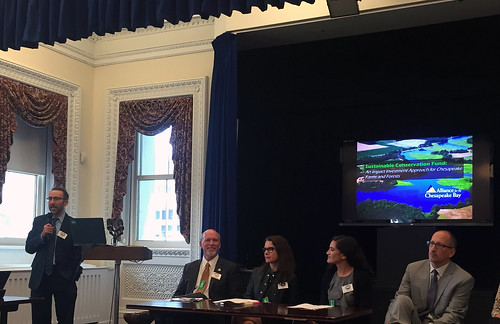
This isn’t your typical Conservation Innovation Grant (CIG) project. There’s no university collecting and analyzing data, or ground-breaking technology being evaluated here.
Nope. This one is a good, old-fashioned meeting.
Why would a meeting be such an important CIG project? Because strategic stakeholders from all over the world come together to deliberate on obstacles, challenges, and generate solutions to increase the amount of private capital, institutional investments, and other sources of non-Federal funding dedicated to natural resource conservation on both public and private lands.
They ask questions like: How can we make it easier for farmers, ranchers, and forest landowners to participate in carbon markets? What are new approaches for funding water quality improvements and green infrastructure? How can the next Farm Bill be leveraged to facilitate private investment in working lands conservation?
“We have to find new ways to compensate producers for the water quality, air quality, and wildlife habitat improvements they provide,” said USDA’s Natural Resources Conservation Service (NRCS) Chief Jason Weller. “NRCS is committed to developing new partnerships and tools to support conservation finance approaches.”
These complex questions and more were on the minds of attendees of the Conservation Finance Practitioners Roundtable (Roundtable) recently held in Washington, D.C. at the White House.
Seventy people—representing conservation investment firms, nonprofit organizations, Federal agencies and more—met to explore ways to increase private capital investment in working lands conservation.
The Conservation Finance Network conceived the Roundtable as a forum, which is scheduled to meet two to three times a year, over the next three years.
The Roundtable is administered and organized by the Conservation Finance Network in close cooperation with the NRCS Environmental Markets and Conservation Finance Team. The NRCS provides financial and strategic support for the Roundtable through its Conservation Innovation Grants (CIG) program.
In addition to the Roundtable project, NRCS funded 21 conservation finance projects through CIG in 2015 and 2016. Below are examples of these innovative projects:
- The Climate Trust established a new Working Lands Carbon Facility to fund greenhouse gas emissions reduction projects on farms, ranches, and forested lands (anaerobic digesters, grassland projects, and improved forest management).
- Investment capital firm Encourage Capital is establishing a Working Lands Investment Fund to stimulate investment in voluntary conservation through the purchase of carbon credits generated by producers.
- Fresh Coast Capital is piloting an innovative approach to financing green infrastructure in legacy cities through impact investing in urban agroforestry and harvestable crops.
The Roundtable project helps projects like these define voluntary working-lands conservation in the 21st Century. The challenges of providing food and fiber over the next century are enormous, the challenge also provides a unique opportunity to view conservation through a new lens.
Read a recent op-ed from Chief Weller on the Conservation Finance Network website and learn more about how the Chief views this opportunity to deploy significant investment capital to protect, restore and maintain our natural ecosystem.
Learn more about the 2016 conservation finance CIG projects here.

